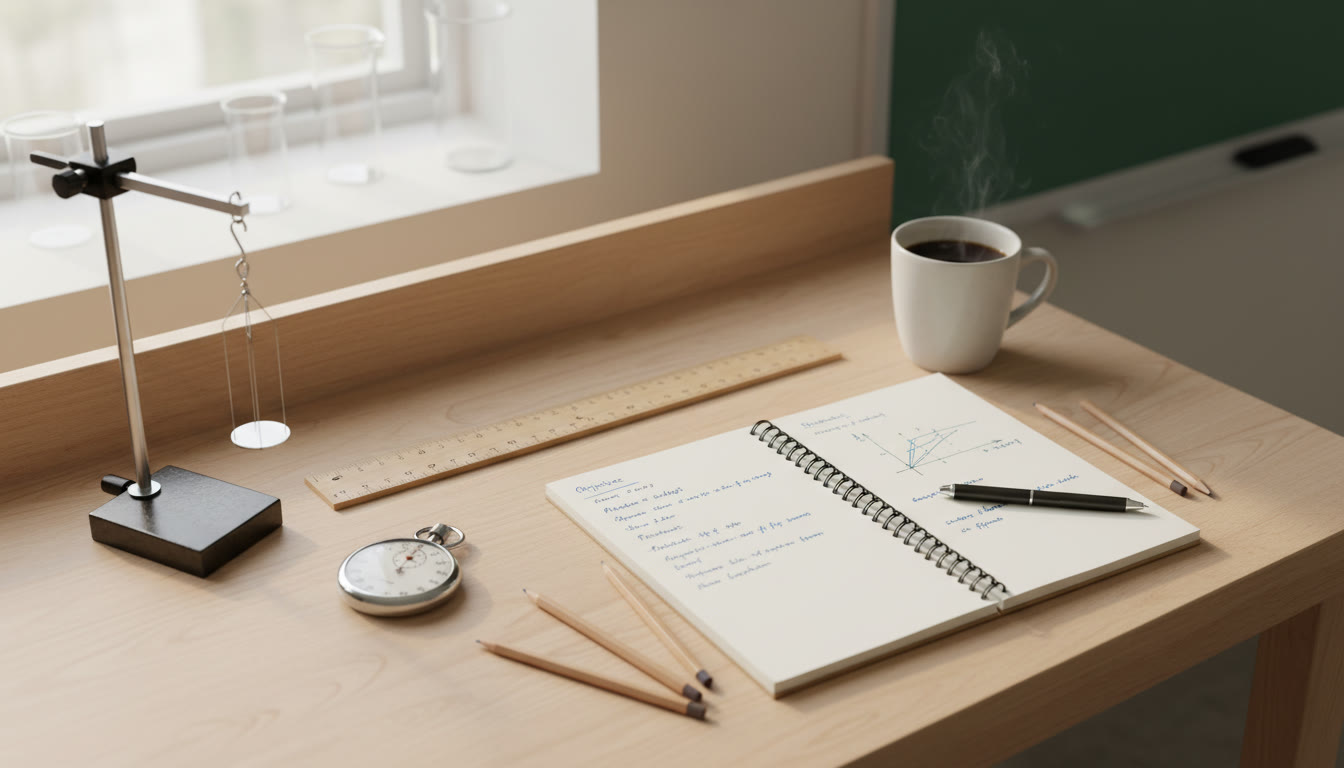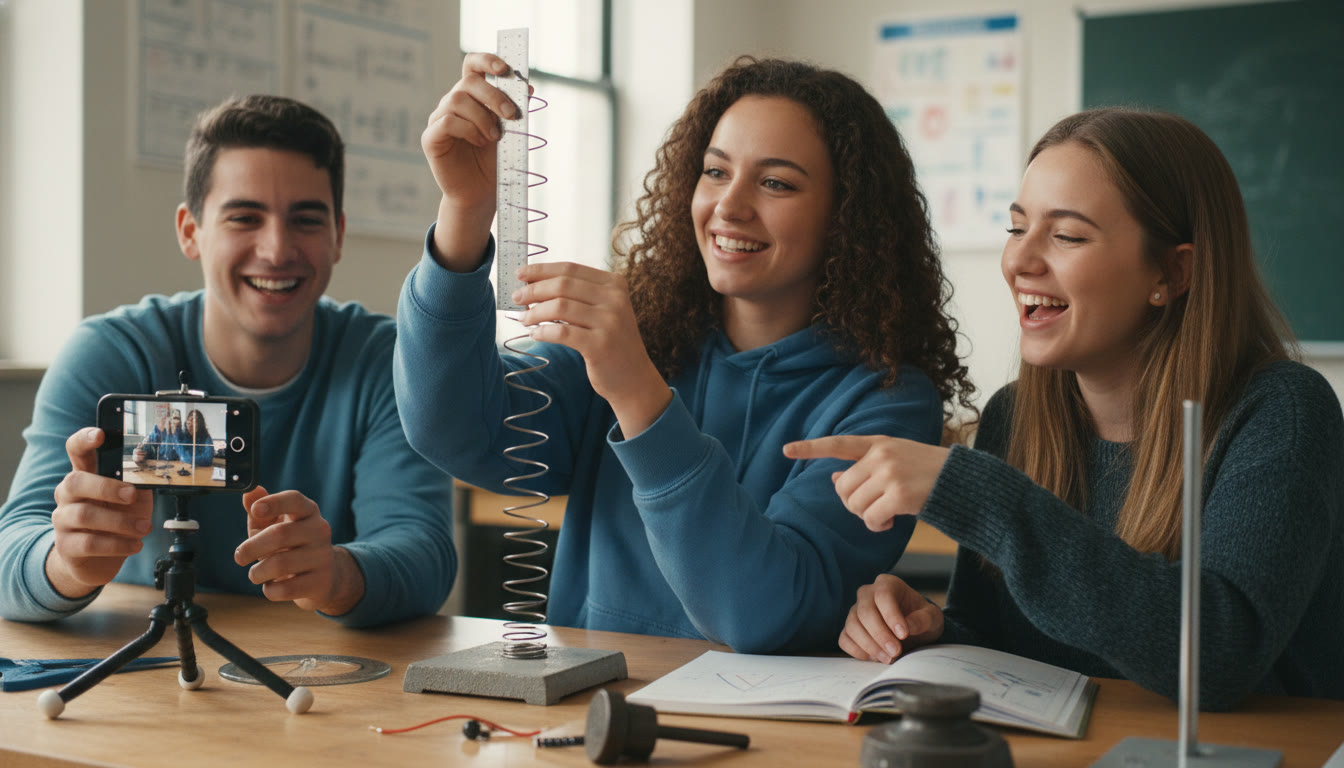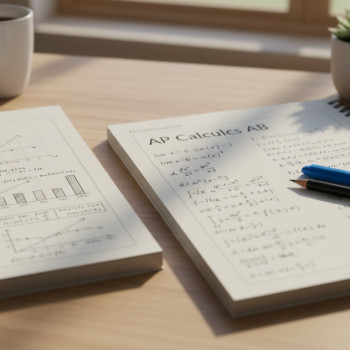Physics 1 Experimental Design: Mastering Uncertainties & Controls
Why experimental design matters for AP Physics 1
Think of experimental design as the roadmap for a successful science investigation. In AP Physics 1, the exam and lab work reward not only correct answers but also the ability to design clean experiments, reason about errors, and justify your controls. A great experiment answers a question in a way that others could repeat, critique, and learn from.

Big picture: Uncertainties, controls, and why they’re your friends
When you design an experiment you’re juggling three core things: a clear hypothesis, a plan for collecting data, and a scheme for reducing or quantifying uncertainty. Controls are how you keep the question pure (so your variable of interest actually causes the observed effect). Uncertainties tell you how much faith to place in your numbers. Together they turn messy reality into useful science.
Step-by-step: Designing an AP Physics 1 experiment
1. Define a focused, testable question
A good question is specific. Instead of “How does mass affect motion?” try “How does the mass of a cart affect its acceleration down a 10° incline when pushed with a constant force?” The second question has an independent variable (mass), a dependent variable (acceleration), and clear conditions (10° incline, constant push).
2. State a hypothesis with reasoning
Don’t only say what you expect — say why. For the incline example: “If mass increases while applied force and incline remain constant, then acceleration will decrease because a = F/m (Newton’s second law).” Explicit links to physical laws demonstrate understanding and help frame the measurement strategy.
3. Identify variables and controls
- Independent variable: the one you change (e.g., mass of the cart).
- Dependent variable: what you measure (e.g., acceleration).
- Controlled variables: things you hold constant (incline angle, force applied, frictional surface, release method).
Controls reduce confounding factors. If you change mass and angle at the same time, you can’t tell which change caused the acceleration change.
4. Choose measurement methods and instruments
List instruments and their limits: stopwatch (±0.01 s? often ±0.1 s in hand timing), photogates (±0.001 s), meter stick (±0.5 mm), digital scale (±0.1 g). Choose methods that make your measurement uncertainties smaller than the effect you expect to detect. If your predicted change in acceleration is tiny, a noisy stopwatch won’t cut it.
5. Plan the procedure with repetition and randomization
Design a stepwise procedure that another student could follow. Include how many trials to run (usually 3–5 minimum for AP-style labs) and how you will randomize or counterbalance order effects (e.g., alternate heavy and light masses rather than doing all light then all heavy). Repetition reduces random error and helps you estimate uncertainty.
Understanding and quantifying uncertainties
Types of uncertainties: systematic vs. random
Random uncertainties fluctuate in an unpredictable way between trials (e.g., human reaction time when starting/stopping a stopwatch). Systematic uncertainties bias all measurements in one direction (e.g., a miscalibrated scale that reads 0.05 kg too high). Your analysis must consider both.
Estimating random uncertainty
Common approaches:
- Standard deviation of repeated measurements (best when you have many repeats).
- Range or half-range when you have few repeats (AP-appropriate when trials are limited): uncertainty ≈ (max − min)/2.
- Propagation of uncertainties: when you calculate a derived quantity (like acceleration from distance and time), use error propagation rules to estimate the uncertainty in the result.
Estimating systematic uncertainty
Identify potential biases and either calibrate them out or estimate their magnitude. For example, if a meter stick’s zero mark is worn, measure and correct it, or add that uncertainty to your totals. Documenting possible systematic errors shows scientific maturity, even if you can’t fully eliminate them.
Propagating uncertainties — the essentials
When your result is computed from measurements (e.g., mean velocity = Δx/Δt), the uncertainty in the result depends on uncertainties in the measured quantities. A few helpful rules that are easy to apply in AP-style work:
- For addition/subtraction: absolute uncertainties add. If Q = A + B, then ΔQ ≈ ΔA + ΔB.
- For multiplication/division: fractional (percent) uncertainties add. If Q = A × B or Q = A / B, then (ΔQ/Q) ≈ (ΔA/A) + (ΔB/B).
- For powers: multiply fractional uncertainty by the exponent. If Q = A^n, then (ΔQ/Q) ≈ |n| (ΔA/A).
Example: If you calculate acceleration a = 2Δx / t^2, then its fractional uncertainty has a contribution of twice the fractional uncertainty in t plus the fractional uncertainty in Δx (weighted appropriately). Even if you don’t do formal propagation, show the logical steps and which measurements limit your accuracy.
Reporting uncertainties clearly
Always report a value with its uncertainty: a = 1.23 ± 0.05 m/s^2. Round the uncertainty to one significant figure (two if the first is a 1) and match the value’s decimal place. This small formatting rule makes results easy to compare at a glance.
Designing effective controls
Why controls are more than “keeping things the same”
Controls isolate the relationship you want to test. They’re not just about repetition — they’re about isolating cause and effect. Good controls reduce alternative explanations for your observation.
Examples of useful controls in AP Physics 1 experiments
- Baseline/control runs: run the system with the independent variable at a reference value (e.g., mass = 0.500 kg) to compare all other trials against.
- Environmental consistency: same room temperature, same surface, same equipment orientation, and so on.
- Calibration checks: measure known standards to verify instrument accuracy (e.g., time a pendulum with a known period or measure a 1.000 m stick).
- Blank or null tests: ensure that observed effects aren’t caused by the measuring device itself (e.g., friction introduced by an added sensor).
Documenting controls in your write-up
When you write your lab report or AP-style response, explicitly list what you controlled and why. Explain how each control reduces a specific alternative explanation. This logical linking earns points and clarifies your reasoning.
Data presentation and analysis
Tables: clarity and completeness
Use tables to present raw data, processed data, and uncertainties. Include units and uncertainties for each column. Here’s a simple template for an incline experiment:
| Trial | Mass (kg) | Distance (m) | Time (s) | Acceleration (m/s²) | Uncertainty in a (m/s²) |
|---|---|---|---|---|---|
| 1 | 0.500 ± 0.001 | 1.00 ± 0.002 | 1.23 ± 0.05 | 1.32 | ±0.07 |
| 2 | 0.700 ± 0.001 | 1.00 ± 0.002 | 1.37 ± 0.05 | 1.07 | ±0.06 |
| Mean | — | — | — | 1.20 | ±0.05 |
Graphs: choosing axes and fitting
Plot the dependent variable vs. the independent variable with error bars. Choose linear or transformed axes so that the physics law becomes linear if possible (e.g., plot acceleration vs. 1/m if you expect a ∝ 1/m relationship). Fit a line when appropriate and show the slope and intercept with uncertainties. Explain how the slope relates to theory (e.g., slope = applied force if a = F/m).
Interpreting fits and residuals
Residuals (the difference between data points and the fit) reveal structure: random scatter is expected, systematic patterns suggest missing physics or biases. Plot residuals under your main graph to demonstrate you didn’t ignore a trend.
Common pitfalls and how to avoid them
Pitfall: Ignoring reaction-time errors
Solution: Use photogates or video analysis when possible. If you must use a stopwatch, measure longer times (so reaction time is a smaller fraction of the reading) and repeat trials to average out the human error.
Pitfall: Changing multiple variables at once
Solution: Keep a clear variable table and change only one independent variable per set of trials. If you need to test two variables, perform separate experiments or use a factorial design where changes are systematic and planned.
Pitfall: Forgetting to calibrate instruments
Solution: Do a quick calibration at the start and end of the lab. For example, time a dropped object from a known height to verify timing technique, or weigh a standard mass to confirm the scale reading.
Writing a strong AP-style lab conclusion
Structure your conclusion
- Restate the question and hypothesis.
- Summarize key results with uncertainties.
- Compare results to theoretical expectation and state whether the hypothesis is supported.
- Discuss sources of uncertainty (random and systematic) and how they affected results.
- Propose realistic improvements and follow-up investigations.
Being candid about limits and honest about what your data show is often more impressive than claiming perfect agreement.
Example concluding paragraph
“Our investigation asked whether increasing mass decreases acceleration for a cart pushed with a constant force down a 10° incline. The measured acceleration decreased from 1.32 ± 0.07 m/s² to 1.07 ± 0.06 m/s² as mass increased, consistent with a = F/m within combined uncertainties. Major uncertainty sources were human timing error and small variations in applied force. Using photogates, standardizing the push with a calibrated spring, and increasing trial counts would reduce uncertainties. Overall, the data support the hypothesis within experimental uncertainty.”
Practical tips for AP Physics 1 test-takers
Time management in lab-based free-response items
On the exam, you often won’t collect data; you’ll design an experiment and reason about uncertainties and controls conceptually. Use concise, labeled lists: state the independent/dependent variables, give a stepwise procedure, identify at least one control and one systematic error, and describe how you would estimate uncertainty. Bullet points are easier to grade than long paragraphs.
What examiners look for
- Clarity: clear identification of variables and controls.
- Reproducibility: a procedure others can follow.
- Quantitative thinking: awareness of how to estimate uncertainties and how they affect conclusions.
- Connection to theory: linking the experiment to relevant physics laws.
Study strategies that actually work
- Practice designing experiments from past AP free-response questions and then compare your approach to scoring rubrics.
- Work through 1–2 real lab setups in school or at home (safely), collecting data and explicitly calculating uncertainties.
- Explain your design aloud to a peer or tutor — teaching is a fast route to clarity.
How targeted tutoring can accelerate your lab skills
Experimental design is a skill that improves most when feedback is prompt and specific. Personalized tutoring — for instance, Sparkl’s 1-on-1 guidance — can help you identify which parts of your methodology introduce the largest uncertainties and learn targeted fixes. A tutor can review an AP-style procedural write-up with you, suggest clearer controls, and coach you on error propagation and effective graphing. If you’re short on lab time at school, personalized coaching paired with thoughtfully designed practice experiments can bridge the gap.
Worked example: Designing an experiment to test Hooke’s law
Question and hypothesis
Question: “Does the extension of a spring depend linearly on the applied force?” Hypothesis: “Extension x is proportional to applied force F, so F = kx, where k is the spring constant.”
Experimental plan
- Independent variable: applied force (use known masses hung from the spring).
- Dependent variable: extension (measure change in length with a meter stick or video analysis).
- Controls: same spring and ambient temperature, measure from the same zero point, ensure masses are added gently to avoid oscillations.
- Procedure: suspend the spring, measure its unstretched length, add masses (0.05 kg increments), wait until motion stops, measure length five times per mass and average, repeat for multiple masses.
Uncertainty analysis
Instrument uncertainties: mass ±0.001 kg (digital scale), length ±0.002 m (meter stick + parallax). Compute force uncertainty from mass uncertainty (ΔF = g × Δm) and propagate to extension if necessary. Plot F vs. x with error bars and fit slope k with uncertainty. Check residuals for systematic deviations (that would indicate non-Hookean behavior at large extensions).
Improvements and extensions
Good follow-ups test limits: does k change for large extensions? Does temperature affect k? Could damping or internal friction produce systematic error? Propose concrete changes: use a stiffer spring, repeat at different temperatures, or use a more precise length measurement method (laser displacement sensor or video tracking).

Final checklist before you hand in a lab or finish an exam response
- Have you clearly stated the hypothesis and linked it to physics?
- Are independent, dependent, and controlled variables labeled?
- Is the procedure reproducible and logically ordered?
- Have you quantified uncertainties and stated major systematic errors?
- Do your tables and graphs include units, significant figures, and error bars?
- Is your conclusion honest about agreement with theory and realistic about improvements?
Parting words — make curiosity measurable
Experimental design is where curiosity meets rigor. The more carefully you think about what might go wrong, the more meaningful your results become. Practice designing experiments, analyze the uncertainties honestly, and treat controls as tools for clearer reasoning, not just boxes to check. And when you need tailored help polishing your techniques, Sparkl’s personalized tutoring can offer the focused feedback that turns good experiments into great ones. With practice and thoughtful design, you’ll not only be ready for AP Physics 1 — you’ll enjoy the detective work that real science invites.
Quick reference: uncertainty rules cheat-sheet
- Addition/subtraction: ΔQ ≈ ΔA + ΔB
- Multiplication/division: (ΔQ/Q) ≈ (ΔA/A) + (ΔB/B)
- Power: (ΔQ/Q) ≈ |n| (ΔA/A) for Q = A^n
- Report values as: value ± uncertainty, with uncertainty rounded to 1 significant figure.
Good luck, and happy experimenting — measuring the world well is the first step to understanding it deeply.



















No Comments
Leave a comment Cancel